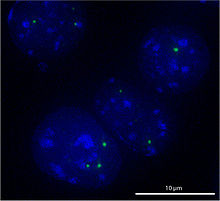- Cajal body
-
Cajal bodies (CBs) are spherical sub-organelles of 0.3-1.0 µm in diameter found in the nucleus of proliferative cells like embryonic cells and tumor cells, or metabolically active cells like neurons. In contrast to cytoplasmic organelles, CBs lack any phospholipid membrane which would separate their content, largely consisting of proteins and RNA, from the surrounding nucleoplasm. They were first reported by Santiago Ramón y Cajal in 1903, who called them nucleolar accessory bodies due to their association with the nucleoli in neuronal cells.[1] These structures were forgotten and later rediscovered by electron microscopists and named coiled bodies according to their appearance as coiled threads on EM images. More recently, to simplify the nomenclature the coiled bodies were renamed after their discoverer.[2] Research on CBs was accelerated after discovery and cloning of the marker protein p80/Coilin.[3] So far, CBs were implicated in important RNA-related metabolic processes such as snRNPs biogenesis, maturation and recycling, histone mRNA processing and telomere maintenance. With regard to CB's role in telomere maintenance, researchers at UT Southwestern Medical Centre showed that CBs assemble RNA which telomerase in turn uses to add nucleotides to the ends of telomeres.[4]
Contents
History
CBs were initially discovered by neurobiologist Santiago Ramón y Cajal in 1903 as small argyrophilic spots in nuclei of silver-stained neuronal cells. Because of their close association with nucleoli he named them nucleolar accessory bodies. Later on, they were forgotten and rediscovered multiple times independently which led to a state where scientists from different research fields used different names for the same structure. Names used for CBs included "spere organelles", "Binnenkörper", "nucelolar bodies" or "coiled bodies". The name coiled bodies comes from observation of electron microscopists Monneron and Bernhard. They described bodies as aggregates composed of coiled threads with thickness of 400-600 Å. When using higher magnification, they appear as tiny, 50 Å thick fibrils irregularly twisted along the axis of the threads. The bodies were even predicted to consist of ribonucleoproteins since treatment of cells with protease and RNase together, but not alone, caused dramatic changes to the structure of CBs.[5]
Localization
Cajal bodies are only found in nuclei of plant, yeast, and animal cells. The cells are usually demonstrating high levels of transcriptional activity, including cells that are rapidly dividing.[6]
CBs and cell cycle
They are about 0.1-2.0 micrometres and are found one to five per nucleus. The number varies in different types of cells and over the cell cycle. Maximum number is reached in mid G1 phase and towards G2 they become larger and their number decreases. CBs disassemble during the M phase and reappear again later in G1 phase. Cajal bodies are possibly sites of assembly or modification of the transcription machinery of the nucleus.[7]
Functions
CBs are bound to the nucleolus by coilin proteins. P80-coilin is a specific marker for coiled bodies,[8] and demonstrates these bodies tend to be associated with the nucleolus when cells are not dividing.
References
- ^ Cajal SR (1903). "Un sencillo metodo de coloracion selectiva del reticulo protoplasmico y sus efectos en los diversos organos nerviosos de vertebrados e invertebrados". Trab Lab Investig Biol Univ Madr 2: 129–221.
- ^ Gall JG, Bellini M, Wu Z, Murphy C (December 1999). "Assembly of the Nuclear Transcription and Processing Machinery: Cajal Bodies (Coiled Bodies) and Transcriptosomes". Mol. Biol. Cell 10 (12): 4385–402. PMC 25765. PMID 10588665. http://www.pubmedcentral.nih.gov/articlerender.fcgi?tool=pmcentrez&artid=25765.
- ^ Andrade LE, Chan EK, Raska I, Peebles CL, Roos G, Tan EM (June 1991). "Human autoantibody to a novel protein of the nuclear coiled body: immunological characterization and cDNA cloning of p80-coilin". J. Exp. Med. 173 (6): 1407–19. doi:10.1084/jem.173.6.1407. PMC 2190846. PMID 2033369. http://www.pubmedcentral.nih.gov/articlerender.fcgi?tool=pmcentrez&artid=2190846.
- ^ Wright, W.E., Zhao, Y.; Abreu, E., Kim, J., Stadler, G., Eskiocak, U., Terns, M.P., Terns, R.M., Shay, J.W. (6). "Processive and Distributive Extension of Human Telomeres by Telomerase Under Homeostatic and Non-equilibrium Conditions". Molecular Cell 42 (3): 297–307. doi:10.1016/j.molcel.2011.03.020. PMC 3108241. PMID 21549308. http://www.cell.com/molecular-cell/abstract/S1097-2765(11)00248-6.
- ^ Monneron A, Bernhard W (May 1969). "Fine structural organization of the interphase nucleus in some mammalian cells". J. Ultrastruct. Res. 27 (3): 266–88. doi:10.1016/S0022-5320(69)80017-1. PMID 5813971. http://www.sciencedirect.com/science/article/B7MF7-4DR1MH6-14/2/6b749ce5733da01790d4ff0ca5ef3c3a.
- ^ Ogg SC, Lamond A (2002). "Cajal bodies and coilin—moving towards function". J Cell Biol 159 (1): 17–21. doi:10.1083/jcb.200206111. PMC 2173504. PMID 12379800. http://www.pubmedcentral.nih.gov/articlerender.fcgi?tool=pmcentrez&artid=2173504.
- ^ Cremer T, Cremer C (2001). "Chromosome territories, nuclear architecture and gene regulation in mammalian cells". Nat Rev Genet 2 (4): 292–301. doi:10.1038/35066075. PMID 11283701.
- ^ Raska I, Ochs RL, Andrade LE et al. (1990). "Association between the nucleolus and the coiled body". J. Struct. Biol. 104 (1–3): 120–7. doi:10.1016/1047-8477(90)90066-L. PMID 2088441.
Structures of the cell nucleus / nuclear protein Envelope (membrane)/
nuclear laminaNucleolus Other Chromatin · Dot (PML body) · Paraspeckle
SMC protein: Cohesin (SMC1A, SMC1B, SMC3) · Condensin (NCAPD2, NCAPD3, NCAPG, NCAPG2, NCAPH, NCAPH2, SMC2, SMC4) · DNA repair (SMC5, SMC6)
Transition nuclear protein: TNP1, TNP2
Nuclear matrix · Nucleoplasm · Nucleoskeleton · Nucleosol
see also transcription factors and intracellular receptorssee also nucleus diseases
B strc: edmb (perx), skel (ctrs), epit, cili, mito, nucl (chro)Categories:- Organelles
- Nuclear substructures
- Cell nucleus
- Cell anatomy
- Cell biology stubs
Wikimedia Foundation. 2010.

